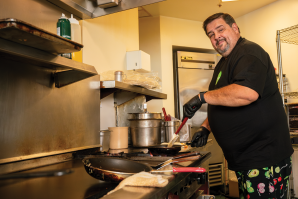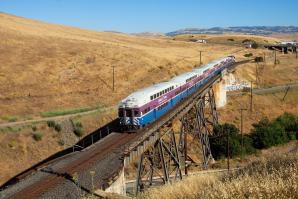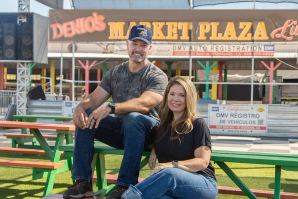Stephanie Miller remained optimistic about the future of the Rio City Café in 2019, even though the City of Sacramento had shut down part of the patio dining area for safety reasons. Most of the building, owned by the city, stands over the Sacramento River on wooden pilings.
Miller and her husband, Mark, then co-owners of the popular restaurant, had reported their concerns about the deck to the city and expected the problems would be fixed.
Miller had another reason for optimism that year: The City Council had approved a $40 million plan to revitalize Old Sacramento Waterfront, including adding new docks and other attractions to the historic district next to the Tower Bridge. The attractions promised to draw many new customers to the restaurant.
“It is sad when an institution like that, that’s been around for so long and been so loved, is closed. They were more than business owners. They were involved in the community — they had skin in the game.”Janie Desmond-Ison, Owner, Steamers restaurant, Old Sacramento
The city has an interest in the success of Old Sacramento Waterfront not only because it collects tax revenue from businesses but also because it owns most of the property and leases it to businesses.
Mayor Darrell Steinberg, who led the revitalization effort, spoke about the need for Old Sacramento Waterfront to become a place where locals went on “date night” and not a place where you “brought your cousins” because they’ve never seen the national historic landmark.
The district tells the story of the Gold Rush, the railroads, Sacramento’s beginnings and more, but it has a reputation as being merely a tourist novelty spot with gag gift and candy shops. The city wanted a place that inspired civic pride, like San Diego’s Gaslamp District, Beale Street in Memphis and other historic business districts.
The Rio City Café stopped operating in August after the City of
Sacramento closed the dining patio (center) for safety reasons.
The city, which owns the building, closed the other outdoor
dining section, to the right, for the same reason in 2019.

Economic development officials enthusiastically supported the plan, which was approved after the city held public workshops and received proposals from consulting firms.
“We have an opportunity to remake our waterfront and change the identity that this region has for Sacramento,” Michael Ault, executive director of the Downtown Sacramento Partnership, told the City Council at the time. “If we’re going to be a river city, we’ve got to have a river city destination.”
The project manager told the council that construction would start in 2020 and conclude by 2023.
Construction never started, for reasons that were never made clear to Miller and other Old Sacramento Waterfront business owners. City spokeswoman Jennifer Singer blames a decline in hotel tax revenue during the COVID-19 pandemic. But the revenue, the primary funding source for the project, returned to pre-pandemic levels two-and-a-half years ago and stayed there.
The city also decided not to fix the deck at Rio City Café, and Miller says she’s never received a full explanation from the city about why. The city monitored the deck for safety issues for four years and made temporary fixes before getting an estimate for fixing the deck in 2023. This year, city staff decided the cost was too high and told the owners to close the remaining patio section.
In a written statement, Singer says the work would cost more than $5 million. The estimate includes $1 million for city staff time, $670,000 for previous work on the deck and $900,000 for contingencies, according to documents obtained through the California Public Records Act. The city expected to pay contractors $2.8 million for the work.
The cafe was left without any seating on the patio overlooking the river, which was always a big part of its appeal. Rio City also had less than a third of the seating it once had. The owners tried to operate with the limited seating before deciding the math no longer worked and closed the restaurant in August.
“It’s been very upsetting,” says Miller, whose father-in-law
opened the restaurant in 1994. “It’s been like a death in the
family.”
In social media posts, former patrons expressed sympathy for
Miller and her husband and anger towards the city. They recalled
birthdays, marriage proposals and other milestones they
experienced at the Rio City Café.
“We live two hours away from Sacramento but would come several times a year to stay at Embassy Suites and have dinner at Rio City Café,” Margaret Rench posted on the cafe’s Facebook page. “We have enjoyed many anniversary dinners out on that lovely deck!”
“Disappointing this place has closed since Sac wouldn’t repair the deck area. I visited on the last day and got the clam chowder and the cheese bread. Both were great. Met the business owner and you could tell she had her heart and soul in this place,” another woman posted on Yelp.
Janie Desmond-Ison is the owner of Steamers, a restaurant she opened next to the Rio City Café the same year the cafe opened. She didn’t consider the cafe a competitor, but rather a partner, with she and other business owners trying to make the Old Sacramento Waterfront a better place.
“It is sad when an institution like that, that’s been around for so long and been so loved, is closed,” she says. “They were more than business owners. They were involved in the community — they had skin in the game.”
Steve Hansen, who represented Old Sacramento Waterfront when he served on the City Council, says the city made a mistake in its handling of the Rio City Café.
“The city should have spent the money to preserve the riverfront restaurant experience, whether it was for Rio City or some other restaurant,” says Hansen, who led the push for the revitalization of Old Sacramento five years ago, along with Steinberg.
The loss of the cafe isn’t just about losing a restaurant. It also marks the loss of a place to see the Sacramento River, which is strangely not easy to find in a district with “waterfront” in its name.
A Ferris wheel and a merry-go-round operate year-round at Old
Sacramento Waterfront. Other attractions include train and boat
rides, car, train and local history museums, and restaurants.

Trees, buildings, river pilings and other objects block or clutter the view of the river from Old Sacramento, which sits atop a levee that further obstructs the view. As Desmond-Ison has told city officials, the question she and her employees receive the most at Steamers: Where is the river? You can throw a rock into the Sacramento River from her restaurant, even if you can’t see it, she adds.
Old Sacramento, which was the start of the existing city, has long been isolated from the Sacramento and American rivers, largely for safety reasons. Old Sacramento was the site of destructive and deadly floods — including the Great Flood of 1862 — which led to the rechanneling of the American River, from just north of Old Sacramento to its current location a mile north.
Officials also isolated Old Sacramento from the rivers by building levees and by raising buildings more than 20 feet with manual jacks, a story visitors can hear and see on the Old Sacramento Underground Tour led by the Sacramento History Museum.
Making the Sacramento River a greater part of the Old Sacramento Waterfront experience was the focus of the revitalization plan from Stantec Architecture in 2019. The City Council approved just under $1 million to pay Stantec for work on the project, before the brakes were put on in 2020.
Stantec called the plan a “River-Oriented Waterfront.” The
project aimed to show visitors the Sacramento River in different
ways:
The “Front Street Experience” — a collection of buildings,
structures and public spaces — would feature two elevated,
open-air gathering spaces with views of the river.
An entertainment deck would be built atop the three-story, city-owned Sacramento History Museum. The deck would “create a premiere space for events with views of the Sacramento River and waterfront,” according to a report prepared for the City Council.
Stephanie Miller says the closure of the Rio City Café, which she
co-owned with her husband, Mark, is like a “death in the family.”
She stands in front of the deck the city closed for safety
reasons, prompting the couple to close the 30-year-old
restaurant.

River docks would improve and expand the existing docks, allowing for more boats and more people.
After the plan’s submission, city staff decided that the dock improvements were not eligible for funding from the hotel tax. But city voters remedied that in 2022 by amending the hotel tax ordinance.
The city points to a decline in hotel tax revenue as the reason for pausing the project, but revenues rebounded the same year that voters made necessary changes to the law.
Hotel tax revenues went down 30 percent in fiscal 2020, the first fiscal year after the start of the pandemic, and stayed about the same the following fiscal year. In fiscal 2022, revenues went back up and have averaged $40 million over three fiscal years, including the current one, compared to an average of $39 million in the four fiscal years prior to the pandemic.
The revitalization project was expected to bring additional revenue to the city. The city would receive an estimated $1.2 million in additional tax revenue each year from increased consumer and business spending.
The City Council was not publicly asked to halt the project. The decision was made by city staff. That was a mistake, says former Councilman Hansen. “The elected officials need to hold city staff accountable,” he says. “It’s imperative for the city to continue to invest in Old Sacramento.”
Steamers restaurant owner Desmond-Ison is upset the City Council has not held a public discussion on the plan since approving it five years ago. “A lot of us spent a lot of time and energy on it and the city spent a lot of time and money on it — and poof, it’s gone, with no explanation,” she says. “There’s no accountability on any of these decisions.”
Steinberg says he wants to bring the plan back to the council before the end of the year when he leaves office. “This is taking some time,” he says. “The approach is slightly different, but the goal is the same — revitalizing our waterfront.”
Steinberg says the city is soliciting proposals from the business community about what can be done with the old Rio City Café location. Other parts of the revitalization plan could still be used in conjunction with a new plan for the cafe location, he says.
City spokeswoman Singer says the plan to revitalize Old Sacramento has no timeline.
The city’s handling of the revitalization project mirrors its handling of the Rio City Café. The council approved the construction estimate, but city staff never asked the council to vote on the work itself. Steinberg says the council should have voted on the proposed cafe project. But, he added, he wouldn’t have supported construction on the cafe because it was too much money to spend on it.
Former cafe owner Miller says she’s still scratching her head about the decision. “We have loved being a part of people’s lives. That’s why it feels like a death in the family,” she says. “Why did they not fix our patio when we’ve been good tenants? Why did this administration choose to let it sit empty?”
Recommended For You

How Did We Get Here?
A politician, a pastor, a PR exec, a psychologist and a professor try to get at the root of the ugly discourse in our country
The drivers of divisiveness were decades in the making. From the 1950s to 1980s, the “Big Three” networks of ABC, NBC and CBS created a sort of monoculture — a shared set of TV shows, water cooler talk and facts that society could agree on. Today, the news media is fractured, and we can’t even agree on the facts.

How the $20 Minimum Wage Is Playing Out
The law was written to target big fast-food chains — but that’s not how it’s working in the Capital Region
As economists and advocates debate the merits, the experiences of restaurant owners in the region offer some evidence of what happens in practice.

What’s Holding Up Valley Rail?
The need and the plan are there, but bureaucracy once again slows progress
The project has been caught in spiraling delays, and launch dates have been pushed back to 2030. The San Jose Regional Rail Commission broke ground on just one of the half dozen proposed new stations as of late summer 2024.

The Value of Art
4 years out of the pandemic, Sacramento’s arts scene brings in tourism and tax dollars
A 2022 study conducted by Americans for the Arts in partnership with Sacramento Alliance for Regional Arts found that nonprofit arts- and culture-related activities in Sacramento County injected over $241 million into the local economy.

Is Our Future Tied to the Tracks? with James Stout
PODCAST EPISODE: Journalist James Stout delves into his latest feature for Comstock’s “What’s Holding Up Valley Rail?” where he investigated delays in railway expansion throughout the Central Valley. We discuss the hurdles that are baked into the system, changing attitudes towards public transit and whether hopping on a train might be more commonplace in future America.

Shining Lights
Hobrecht Lighting and Lofings Lighting have longevity while competitors have come and gone
At a time when anyone can order lighting fixtures off Amazon or wander the aisles of Home Depot or Lowe’s and select something readily available and cheap, visiting Hobrecht or Lofings can feel like a trip to a different era. Still, there’s a story worth telling connected to each of these Sacramento stores which shows how family businesses can endure even in changing times.

Roseville’s Unique Shopping and Entertainment Gathering Place
Family business spotlight: The Denio family embraces the future while honoring their roots
Eric and Tracy Denio remember Roseville before it was a suburban powerhouse — back when their childhood days were spent roaming among fields, ranches, ponds and gravel pits. Flash forward to today, and Denio’s Farmers Market & Swap Meet is surrounded by oceans of homes and shopping centers that span for miles in every direction. But one thing that hasn’t changed is its ethos.

A Pioneer in Organic Farming
Family business spotlight: Pleasant Grove Farms in Sutter County grows popcorn, wheat and rice the natural way
Driving along a country road in rural Sutter County and seeing endless rows of corn, you can’t help but think of the movie “Field of Dreams.” The Sills family decided to build their dream eight decades ago. Pleasant Grove Farms, a family-owned, certified organic grain and bean farm, has been growing corn and other crops for nearly 80 years.




